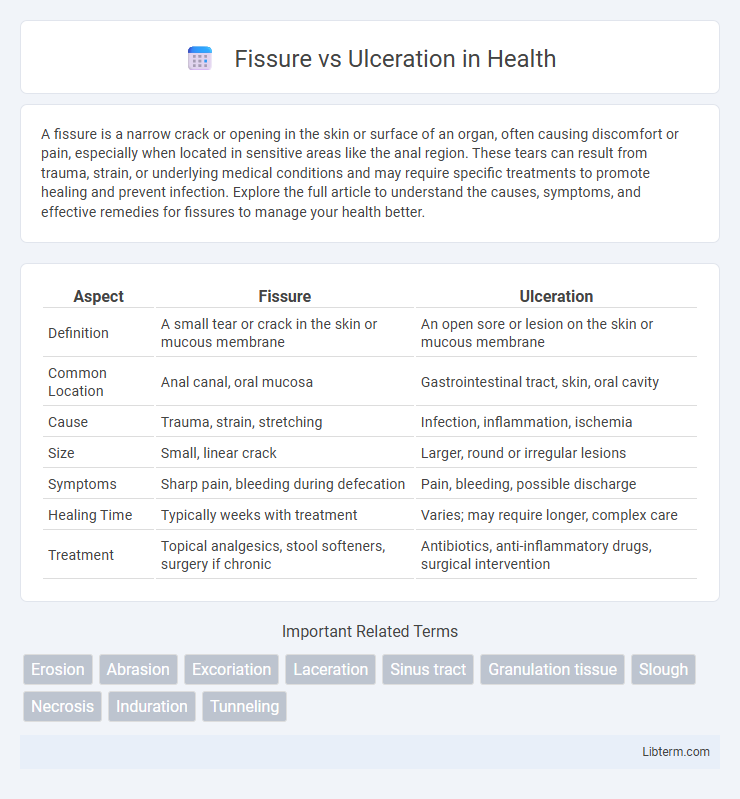A fissure is a narrow crack or opening in the skin or surface of an organ, often causing discomfort or pain, especially when located in sensitive areas like the anal region. These tears can result from trauma, strain, or underlying medical conditions and may require specific treatments to promote healing and prevent infection. Explore the full article to understand the causes, symptoms, and effective remedies for fissures to manage your health better.
Table of Comparison
| Aspect | Fissure | Ulceration |
|---|---|---|
| Definition | A small tear or crack in the skin or mucous membrane | An open sore or lesion on the skin or mucous membrane |
| Common Location | Anal canal, oral mucosa | Gastrointestinal tract, skin, oral cavity |
| Cause | Trauma, strain, stretching | Infection, inflammation, ischemia |
| Size | Small, linear crack | Larger, round or irregular lesions |
| Symptoms | Sharp pain, bleeding during defecation | Pain, bleeding, possible discharge |
| Healing Time | Typically weeks with treatment | Varies; may require longer, complex care |
| Treatment | Topical analgesics, stool softeners, surgery if chronic | Antibiotics, anti-inflammatory drugs, surgical intervention |
Definition of Fissure
A fissure is a narrow, elongated crack or groove in the skin or mucous membrane, often caused by trauma or inflammation, and characterized by its linear and sharply defined edges. Unlike ulcers, which are open sores with tissue loss extending into the dermis or deeper layers, fissures typically involve superficial splitting without significant tissue destruction. Clinically, fissures commonly occur in areas subjected to mechanical stress, such as anal fissures in the anus, distinguishing them by their painful, sharp edges compared to the broader, inflamed base of ulcers.
Definition of Ulceration
Ulceration refers to the formation of a break or open sore in the mucous membrane or skin that results from the loss of surface tissue, often accompanied by inflammation and necrosis. Unlike fissures, which are narrow, linear cracks or splits typically occurring in the skin or mucosa, ulcerations involve broader, more extensive tissue damage. Common causes of ulceration include infections, chronic inflammation, malignancies, and ischemic conditions affecting epithelial integrity.
Key Differences Between Fissure and Ulceration
Fissures are linear cracks or tears in the skin or mucous membrane, often caused by trauma or chronic inflammation, whereas ulcerations are deeper breaches that extend into the underlying tissue layers, resulting in tissue loss. Fissures typically appear as narrow, well-defined splits with sharp edges, while ulcerations present as open sores with irregular borders and may bleed or become infected. The healing process differs, with fissures often healing faster due to limited tissue damage, whereas ulcerations may require prolonged treatment due to involvement of submucosal or dermal layers.
Common Causes of Fissures
Fissures are small tears or cracks in the skin or mucous membranes, commonly caused by trauma, chronic constipation, or anal strain, whereas ulcerations represent deeper tissue breakdown often linked to infections or chronic diseases. Frequent causes of fissures include prolonged diarrhea, childbirth, or passage of hard stools, leading to localized pain and bleeding. Unlike ulcers, fissures often heal spontaneously with conservative treatment, emphasizing the importance of addressing underlying mechanical stressors for effective recovery.
Typical Causes of Ulcerations
Ulcerations typically result from infections, chronic inflammation, vascular insufficiency, or prolonged pressure causing tissue breakdown. Common infectious agents include Helicobacter pylori in gastric ulcers and herpes simplex virus in oral ulcers. Other causes involve autoimmune conditions like Crohn's disease and exposure to irritants such as nonsteroidal anti-inflammatory drugs (NSAIDs).
Symptoms of Fissures
Fissures present as sharp, severe pain during bowel movements, often accompanied by visible tears or cracks in the anal skin. Symptoms include bleeding, itching, and a burning sensation around the affected area. These painful sensations differentiate fissures from ulcerations, which may manifest with more diffuse or less intense discomfort.
Symptoms of Ulcerations
Ulcerations present with symptoms such as persistent pain, redness, and swelling in the affected area, often accompanied by bleeding or discharge. Patients may experience a burning or throbbing sensation, especially during bowel movements if located in the anal region. Unlike fissures, which typically cause sharp, localized pain, ulcerations can result in more diffuse discomfort and prolonged healing times.
Diagnosis: Fissure vs Ulceration
Diagnosis of fissure versus ulceration primarily involves clinical examination, where fissures appear as linear, shallow breaks in the mucosa, commonly found in areas subjected to mechanical stress, while ulcerations present as deeper, well-defined mucosal defects with potential surrounding inflammation. Histopathological analysis can further differentiate these lesions, with fissures showing minimal inflammatory infiltrate and ulcerations demonstrating tissue necrosis and chronic inflammatory cells. Imaging and biopsy are crucial when malignancy or infection is suspected to confirm the diagnosis and guide treatment.
Treatment Approaches for Fissures
Treatment approaches for fissures primarily focus on promoting healing and reducing pain through conservative methods including topical nitroglycerin, calcium channel blockers, and sitz baths. In refractory cases, botulinum toxin injections or lateral internal sphincterotomy may be recommended to alleviate sphincter spasm and facilitate healing. Proper hygiene, stool softeners, and dietary modifications complement these treatments by minimizing strain and irritation at the fissure site.
Treatment Approaches for Ulcerations
Treatment approaches for ulcerations primarily involve topical medications such as corticosteroids and calcineurin inhibitors to reduce inflammation and promote healing. In more severe cases, systemic immunosuppressants or biologics may be prescribed to manage underlying conditions like Crohn's disease or autoimmune disorders. Proper wound care, including dressings and infection control, is essential to prevent complications and support tissue regeneration.
Fissure Infographic

 libterm.com
libterm.com